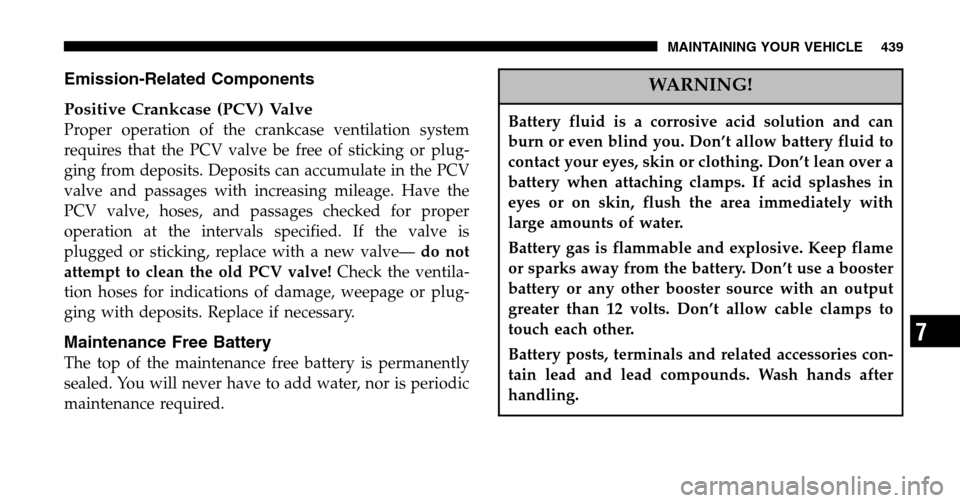Page 429 of 536

For states which have an I/M (Inspection and
Maintenance) requirement, this check verifies the
following: the MIL (Malfunction Indicator Lamp)
is functioning and is not on when the engine is running,
and that the OBD (On Board Diagnostic) system is ready
for testing.
Normally, the OBD system will be ready. The OBD
system may notbe ready if your vehicle was recently
serviced, if you recently had a dead battery, or a battery
replacement. If the OBD system should be determined
not ready for the I/M test, your vehicle may fail the test.
Your vehicle has a simple ignition key actuated test
which you can use prior to going to the test station. To
check if your vehicle’s OBD system is ready, you must do
the following:
1. Insert your ignition key into the ignition switch. 2. Turn the ignition to the ON position, but do not crank
or start the engine.
3. If you crank or start the engine, you will have to start
this test over.
4. As soon as you turn your key to the ON position, you
will see your MIL symbol come on as part of a normal
bulb check.
5. Approximately 15 seconds later, one of two things will
happen:
a. The MIL light will blink for approximately 5 sec-
onds and then remain on until the first engine crank or
the key is turned off. This means that your vehicle’s
OBD system is not readyand you should notproceed
to the I/M station.
MAINTAINING YOUR VEHICLE 429
7
Page 430 of 536

b. The MIL light will remain fully illuminated until the
first engine crank or the key is turned off. This means
that your vehicle’s OBD system is readyand you can
proceed to the I/M station.
If your OBD system is not ready,you should see your
dealer or repair facility. If your vehicle was recently
serviced or had a battery failure or replacement, you may
need to do nothing more than drive your vehicle as you
normally would in order for your OBD system to update.
A recheck with the above test routine may then indicate
that the system is now ready.
Regardless of whether your vehicle’s OBD system is
ready or not ready, if the MIL symbol is illuminated
during normal vehicle operation, you should have your
vehicle serviced before going to the I/M station. The I/M
station can fail your vehicle because the MIL symbol is on
with the engine running.DEALER SERVICE
Your dealer has the qualified service personnel, special
tools and equipment to perform all service operations in
an expert manner. Service manuals are available which
include detailed service information for your vehicle.
Refer to these manuals before attempting any procedure
yourself.
NOTE: Intentional tampering with emissions control
systems can result in civil penalties being assessed
against you.
WARNING!
You can be badly injured working on or around a
motor vehicle. Do only that service work for which
you have the knowledge and the proper equipment. If
you have any doubt about your ability to perform a
service job, take your vehicle to a competent mechanic.
430 MAINTAINING YOUR VEHICLE
Page 435 of 536

the engine oil. Engine oil is an engineered product and
it’s performance may be impaired by supplemental ad-
ditives.
Disposing of Used Engine Oil And Oil Filters
Care should be taken in disposing of used engine oil and
oil filters from your vehicle. Used oil and oil filters,
indiscriminately discarded, can present a problem to the
environment. Contact your dealer, service station, or
governmental agency for advice on how and where used
oil and oil filters can be safely discarded in your area.
Engine Oil Filter
The engine oil filter should be replaced at every engine
oil change.
Engine Oil Filter Selection
The manufacturer’s engines have a full-flow type oil
filter. Use a filter of this type for replacement. The quality
of replacement filters varies considerably. Only high quality filters should be used to assure most efficient
service. Mopar Engine Oil Filters are a high quality oil
filter and are recommended.
Drive Belts — Check Condition and Tensioner
Belt tension is controlled by means of an automatic
tensioner. No belt tension adjustments are required.
However, belt and belt tensioner condition should be
inspected at the specified intervals and replaced if re-
quired. See your authorized dealer for service.
At the mileage indicated in the maintenance schedule, all
belts and tensioner should be checked for condition.
Improper belt tension can cause belt slippage and failure.
Belts should be inspected for evidence of cuts, cracks,
glazing or frayed cords and replaced if there is indication
of damage which could result in belt failure. Low gen-
erator belt tension can cause battery failure.
MAINTAINING YOUR VEHICLE 435
7
Page 439 of 536

Emission-Related Components
Positive Crankcase (PCV) Valve
Proper operation of the crankcase ventilation system
requires that the PCV valve be free of sticking or plug-
ging from deposits. Deposits can accumulate in the PCV
valve and passages with increasing mileage. Have the
PCV valve, hoses, and passages checked for proper
operation at the intervals specified. If the valve is
plugged or sticking, replace with a new valve— do not
attempt to clean the old PCV valve! Check the ventila-
tion hoses for indications of damage, weepage or plug-
ging with deposits. Replace if necessary.
Maintenance Free Battery
The top of the maintenance free battery is permanently
sealed. You will never have to add water, nor is periodic
maintenance required.
WARNING!
Battery fluid is a corrosive acid solution and can
burn or even blind you. Don’t allow battery fluid to
contact your eyes, skin or clothing. Don’t lean over a
battery when attaching clamps. If acid splashes in
eyes or on skin, flush the area immediately with
large amounts of water.
Battery gas is flammable and explosive. Keep flame
or sparks away from the battery. Don’t use a booster
battery or any other booster source with an output
greater than 12 volts. Don’t allow cable clamps to
touch each other.
Battery posts, terminals and related accessories con-
tain lead and lead compounds. Wash hands after
handling.
MAINTAINING YOUR VEHICLE 439
7
Page 440 of 536

CAUTION!
It is essential when replacing the cables on the
battery that the positive cable is attached to the
positive post and the negative cable is attached to the
negative post. Battery posts are marked (+) positive
and negative (-) and identified on the battery case.
Also, if a “fast charger” is used while battery is in
vehicle, disconnect both vehicle battery cables be-
fore connecting the charger to battery. Do not use a
“fast charger” to provide starting voltage.
Air Conditioner Maintenance
For best possible performance, your air conditioner
should be checked and serviced by an Authorized Dealer
at the start of each warm season. This service should
include cleaning of the condenser fins and a performance
test. Drive belt tension should also be checked at this
time. NOTE:
Refer to Section 3 of the Warranty Information
book for further warranty information.
WARNING!
•Use only refrigerants and compressor lubricants
approved by the manufacturer for your air condi-
tioning system. Some unapproved refrigerants are
flammable and can explode, injuring you. Other
unapproved refrigerants or lubricants can cause
the system to fail, requiring costly repairs.
•The air conditioning system contains refrigerant
under high pressure. To avoid risk of personal
injury or damage to the system, adding refrigerant
or any repair requiring lines to be disconnected
should be done by an experienced repairman.
440 MAINTAINING YOUR VEHICLE
Page 466 of 536
INTEGRATED POWER MODULE
An integrated Power Module is located in the engine
compartment near the battery. This center contains car-
tridge fuses and mini fuses. A description of each fuse
and component may be stamped on the inside cover otherwise the cavity number of each fuse is stamped on
the inside cover that corresponds to the following chart.
Cavity Cartridge
Fuse Mini
Fuse Description
1 20 Amp Yellow Power Outlet Console
2 20 Amp Yellow CCN Door Locks/
BTSI
3 20 Amp Yellow Spare
4 20 Amp Yellow Spare
5 20 Amp Yellow Power Sunroof
6 10 Amp Red OCM/VIST Fan/
Wastegate
7 15 Amp Blue Reverse Lockout Sole-
noid Battery (SRT-10
Only)
Integrated Power Module Location
466 MAINTAINING YOUR VEHICLE
Page 467 of 536
Cavity Cartridge Fuse Mini
Fuse Description
8 10 Amp Red Heated Mirrors
9 30 Amp Pink Off Road Module
Power
10 5 Amp Orange Trx-Off Rd Pkg Sen
(Gas Engine Only)
11 20 Amp Yellow IOD-CNN/Radio/
Under Hood Lamp/
WCM/SDARS/HFM
12 30 Amp Pink Electric Brake
13 25 Amp Natural Power-Battery
RWAL/ABS Module
Feed
14 15 Amp Blue Park Lamps LeftCavity Cartridge
Fuse Mini
Fuse Description
15 20 Amp Yellow Trailer Park Lamps
16 15 Amp Blue Park Lamps Right
17 15 Amp Blue Spare
18 40 Amp Green ABS Pump
19 30 Amp Pink Trailer Tow
20 10 Amp Red ORC2
21 10 Amp Red ORC Preset Carrier
22 2 Amp Gray IGN Switch Feed
MAINTAINING YOUR VEHICLE 467
7
Page 469 of 536

Cavity Cartridge Fuse Mini
Fuse Description
38 20 Amp Yellow Power Outlet IP
39 10 Amp Red Sunroof/Seatbelt Ten-
sioner
40 20 Amp Yellow Cigar Lighter
41 25 Amp Natural Spare
42 30 Amp Pink Diesel PCM (Diesel
Only)
1. Disconnect the battery negative (-) cable before remov-
ing the cover.
2. Use specified fuses only.
3. Always properly reinstall the cover.VEHICLE STORAGE
If you are storing your vehicle for more than 21 days, we
recommend that you take the following steps to mini-
mize the drain on your vehicle’s battery:
•Disconnect the Ignition-Off Draw fuse (I.O.D.) fuse
located in the Integrated Power Module, located in the
engine compartment. The I.O.D. cavity includes a
snap-in retainer that allows the fuse to be discon-
nected, without removing it from the fuse block.
•The electronic shift transfer case should be placed in
the 4HI mode and kept in this position to minimize the
battery drain.
•As an alternative to the above steps you may, discon-
nect the negative cables from both batteries.
NOTE: When reinstalling the IOD fuse, the gages in the
Instrument Cluster will do a full sweep, when the
ignition key is cycled to RUN. This is a normal condition.
MAINTAINING YOUR VEHICLE 469
7